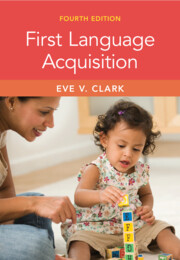Refine search
Actions for selected content:
77 results
Visual support in easy language: The impact of images on comprehension, perceived difficulty and eye movements
-
- Journal:
- Language and Cognition / Volume 17 / 2025
- Published online by Cambridge University Press:
- 28 November 2025, e87
-
- Article
-
- You have access
- Open access
- HTML
- Export citation
Chapter 9 - Personality and Individual Differences in Conversation Memory
-
- Book:
- Conversation Memory
- Published online:
- 09 October 2025
- Print publication:
- 23 October 2025, pp 124-131
-
- Chapter
- Export citation
3 - The Case of Agreement Attraction
-
- Book:
- Linguistic Illusions
- Published online:
- 30 October 2025
- Print publication:
- 02 October 2025, pp 35-61
-
- Chapter
- Export citation
The processing of multi-word expressions: A research agenda for the next 10 years
-
- Journal:
- Language Teaching , First View
- Published online by Cambridge University Press:
- 27 August 2025, pp. 1-20
-
- Article
-
- You have access
- Open access
- HTML
- Export citation
Do gestures and props help communication with older adults about prescription medicine?
-
- Journal:
- Applied Psycholinguistics / Volume 46 / 2025
- Published online by Cambridge University Press:
- 07 August 2025, e20
-
- Article
-
- You have access
- Open access
- HTML
- Export citation
Kant on the Theoretical Use of the Ideas of Reason: A Transcendental Interpretation
-
- Journal:
- Canadian Journal of Philosophy / Volume 54 / Issue 3 / April 2024
- Published online by Cambridge University Press:
- 06 May 2025, pp. 230-250
-
- Article
-
- You have access
- Open access
- HTML
- Export citation
New data on text reading in English as a second language: The Wave 2 expansion of the Multilingual Eye-Movement Corpus (MECO)
-
- Journal:
- Studies in Second Language Acquisition / Volume 47 / Issue 2 / May 2025
- Published online by Cambridge University Press:
- 12 March 2025, pp. 677-695
- Print publication:
- May 2025
-
- Article
-
- You have access
- Open access
- HTML
- Export citation
Instructions
-
- Journal:
- Journal of the Economic Science Association / Volume 4 / Issue 2 / December 2018
- Published online by Cambridge University Press:
- 17 January 2025, pp. 165-179
-
- Article
- Export citation
Null subject comprehension and production revisited: a look at English and Italian
-
- Journal:
- Journal of Child Language , First View
- Published online by Cambridge University Press:
- 13 January 2025, pp. 1-26
-
- Article
-
- You have access
- Open access
- HTML
- Export citation

First Language Acquisition
-
- Published online:
- 01 November 2024
- Print publication:
- 20 June 2024
-
- Textbook
- Export citation
An approach for enhancing and measuring information comprehensibility for engineering designers: applied to patent documents
-
- Article
-
- You have access
- Open access
- HTML
- Export citation
Unveiling readability challenges: An extensive analysis of consent document accessibility in clinical trials
-
- Journal:
- Journal of Clinical and Translational Science / Volume 8 / Issue 1 / 2024
- Published online by Cambridge University Press:
- 16 September 2024, e125
-
- Article
-
- You have access
- Open access
- HTML
- Export citation
16 - Continuity and change
- from Part IV - Process in acquisition
-
- Book:
- First Language Acquisition
- Published online:
- 01 November 2024
- Print publication:
- 20 June 2024, pp 462-496
-
- Chapter
- Export citation
11 - Constructing words
- from Part II - Constructions and meanings
-
- Book:
- First Language Acquisition
- Published online:
- 01 November 2024
- Print publication:
- 20 June 2024, pp 311-338
-
- Chapter
- Export citation
Shared representations in cognate comprehension and production: An online picture naming and lexical decision study with bilingual children
-
- Journal:
- Applied Psycholinguistics / Volume 45 / Issue 3 / May 2024
- Published online by Cambridge University Press:
- 13 May 2024, pp. 489-515
-
- Article
-
- You have access
- Open access
- HTML
- Export citation
6 - Processing and Understanding Discourse Relations and Connectives
-
- Book:
- Connectives and Discourse Relations
- Published online:
- 22 February 2024
- Print publication:
- 29 February 2024, pp 116-141
-
- Chapter
-
- You have access
- Open access
- HTML
- Export citation
22 - Deciphering Directives
- from Part III - Trial Phase Decision-Making
-
-
- Book:
- The Cambridge Handbook of Psychology and Legal Decision-Making
- Published online:
- 22 February 2024
- Print publication:
- 29 February 2024, pp 339-354
-
- Chapter
- Export citation
Metaphor comprehension in the acquisition of Arabic
-
- Journal:
- Journal of Child Language / Volume 52 / Issue 2 / March 2025
- Published online by Cambridge University Press:
- 24 January 2024, pp. 334-354
-
- Article
-
- You have access
- Open access
- HTML
- Export citation
2 - How do I maximize input in the second language?
- from Part I - Teacher and Student Talk
-
- Book:
- The Art and Science of Language Teaching
- Published online:
- 21 December 2023
- Print publication:
- 21 December 2023, pp 22-33
-
- Chapter
- Export citation
How reliable is assessment of children’s sentence comprehension using a self-directed app? A comparison of supported versus independent use
-
- Journal:
- Journal of Child Language / Volume 51 / Issue 6 / November 2024
- Published online by Cambridge University Press:
- 14 September 2023, pp. 1395-1423
-
- Article
-
- You have access
- Open access
- HTML
- Export citation
